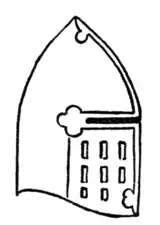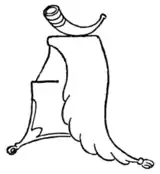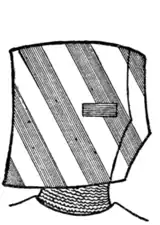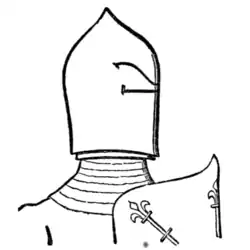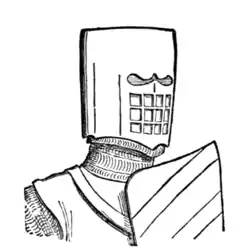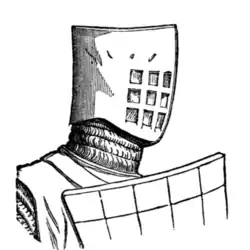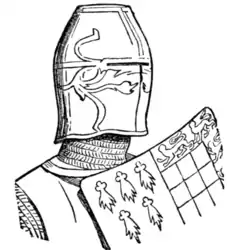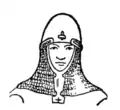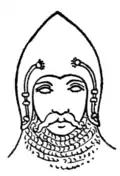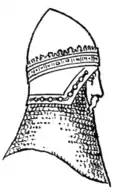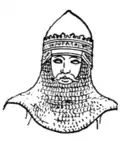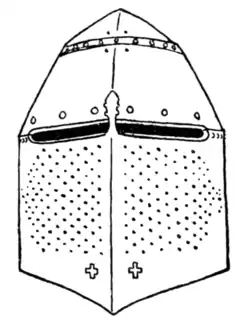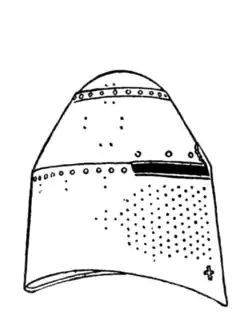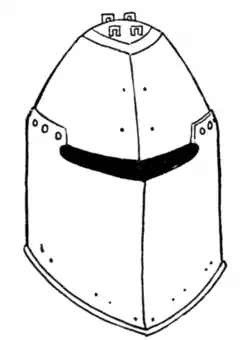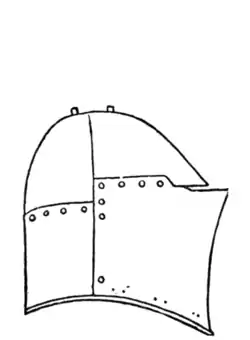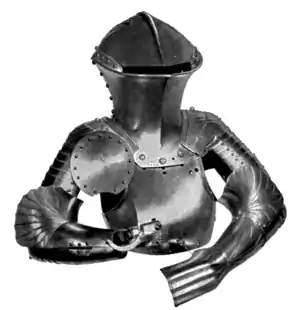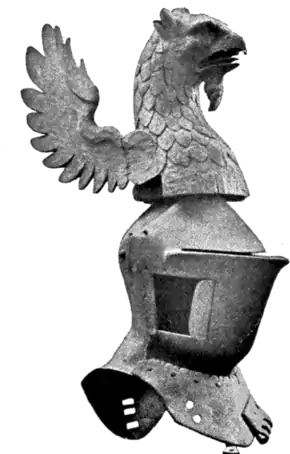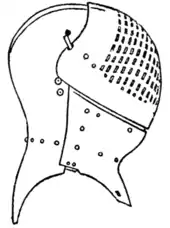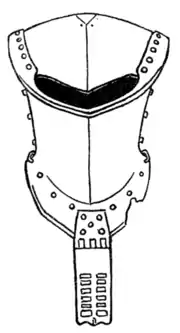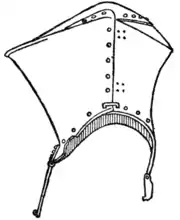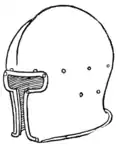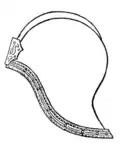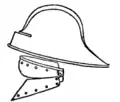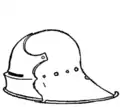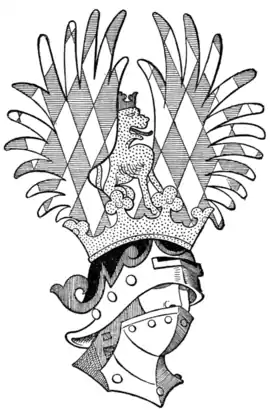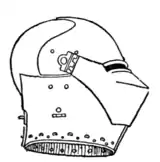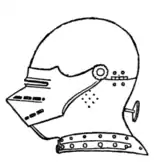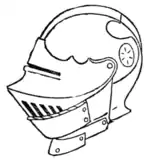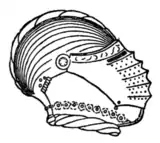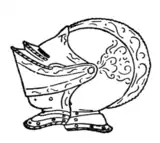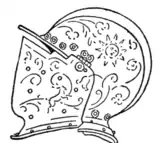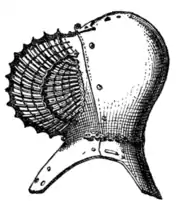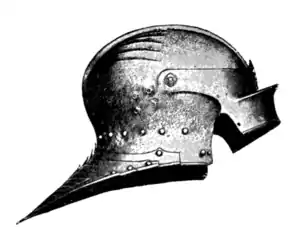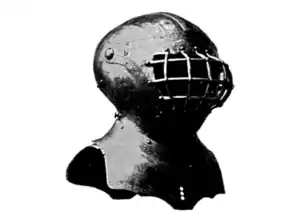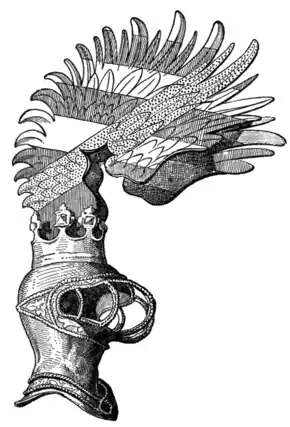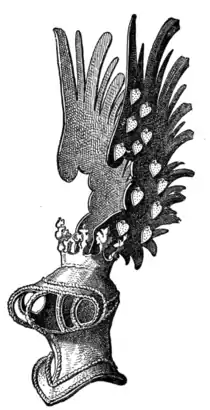CHAPTER XX
THE HERALDIC HELMET
SINCE one's earliest lessons in the rules of heraldry, we have been taught, as one of the fundamental laws of the achievement, that the helmet by its shape and position is indicative of rank; and we early learnt by rote that the esquire's helmet was of steel, and was placed in profile, with the visor closed: the helmet of the knight and baronet was to be open and affronté; that the helmet of the peer must be of silver, guarded by grilles and placed in profile; and that the royal helmet was of gold, with grilles, and affronté. Until recent years certain stereotyped forms of the helmet for these varying circumstances were in use, hideous alike both in the regularity of their usage and the atrocious shapes into which they had been evolved. These regulations, like some other adjuncts of heraldic art, are comparatively speaking of modern origin. Heraldry in its earlier and better days knew them not, and they came into vogue about the Stuart times, when heraldic art was distinctly on the wane. It is puzzling to conceive a desire to stereotype these particular forms, and we take it that the fact, which is undoubted, arose from the lack of heraldic knowledge on the part of the artists, who, having one form before them, which they were assured was correct, under the circumstances simply reproduced this particular form in facsimile time after time, not knowing how far they might deviate and still remain correct. The knowledge of heraldry by the heraldic artist was the real point underlying the excellence of mediæval heraldic art, and underlying the excellence of much of the heraldic art in the revival of the last few years. As it has been often pointed out, in olden times they "played" with heraldry, and therein lay the excellence of that period. The old men knew the lines within which they could "play," and knew the laws which they could not transgress. Their successors, ignorant of the laws of arms, and afraid of the hidden meanings of armory, had none but the stereotyped lines to follow. The result was bad. Let us first consider the development of the actual helmet, and then its application to heraldic purposes will be more readily followed.
To the modern mind, which grumbles at the weight of present-day head coverings, it is often a matter of great wonder how the knights of ancient days managed to put up with the heavy weight of the great iron helmet, with its wooden or leather crest. A careful study of ancient descriptions of tournaments and warfare will supply the clue to the explanation, which is simply that the helmet was very seldom worn. For ceremonial purposes and occasions it was carried by a page, and in actual use it was carried slung at the saddle-bow, until the last moment, when it was donned for action as blows and close contact became imminent. Then, by the nature of its construction, the weight was carried by the shoulders, the head and neck moving freely within necessary limits inside. All this will be more readily apparent, when the helmet itself is considered. Our present-day ideas of helmets—their shape, their size, and their proportions—are largely taken from the specimens manufactured (not necessarily in modern times) for ceremonial purposes; e.g. for exhibition as insignia of knighthood. By far the larger proportion of the genuine helmets now to be seen were purposely made (certainly at remote dates) not for actual use in battle or tournament, but for ceremonial use, chiefly at funerals. Few, indeed, are the examples still existing of helmets which have been actually used in battle or tournament. Why there are so few remaining to us, when every person of position must necessarily have possessed one throughout the Plantagenet period, and probably at any rate to the end of the reign of Henry VII., is a mystery which has puzzled many people—for helmets are not, like glass and china, subject to the vicissitudes of breakage. The reason is doubtless to be found in the fact that at that period they were so general, and so little out of the common, that they possessed no greater value than any other article of clothing; and whilst the real helmet, lacking a ceremonial value, was not preserved, the sham ceremonial helmet of a later period, possessing none but a ceremonial value, was preserved from ceremonial to ceremonial, and has been passed on to the present day. But a glance at so many of these helmets which exist will plainly show that it was quite impossible for any man's head to have gone inside them, and the sculptured helmets of what may seem to us uncouth shape and exaggerated size, which are occasionally to be found as part of a monumental effigy, are the size and shape of the helmets that were worn in battle. This accounts for the much larger-sized helmets in proportion to the size of shield which will be found in heraldic emblazonments of the Plantagenet and Tudor periods. The artists of those periods were accustomed to the sight of real helmets, and knew and drew the real proportion which existed between the fighting helmet and the fighting shield. Artists of Stuart and Georgian days knew only the ceremonial helmet, and consequently adopted and stereotyped its impossible shape, and equally impossible size. Victorian heraldic artists, ignorant alike of the actual and the ceremonial, reduced the size even further, and until the recent revulsion in heraldic art, with its reversion to older types, and its copying of older examples, the helmets of heraldry had reached the uttermost limits of absurdity.
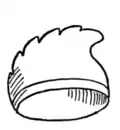 Fig. 560. |
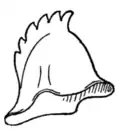 Fig. 561. |
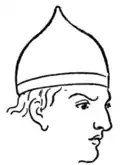 Fig. 562. |
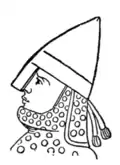 Fig. 563. |
The recent revival of heraldry is due to men with accurate and extensive knowledge, and many recent examples of heraldic art well compare with ancient types. One happy result of this revival is a return to older and better types of the helmet. But it is little use discarding the "heraldic" helmet of the stationer's shop unless a better and more accurate result can be shown, so that it will be well to trace in detail the progress of the real helmet from earliest times.
In the Anglo-Saxon period the common helmet was merely a cap of leather, often four-cornered, and with a serrated comb (Figs. 560 and 561), but men of rank had a conical one of metal (Fig. 562), which was frequently richly gilt. About the time of Edward the Confessor a small piece, of varying breadth, called a "nasal," was added (Fig. 563), which, with a quilted or gamboised hood, or one of mail, well protected the face, leaving little more than the eyes exposed; and in this form the helmet continued in general use until towards the end of the twelfth century, when we find it merged into or supplanted by the
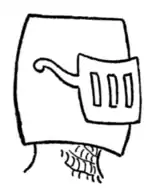 Fig. 564. |
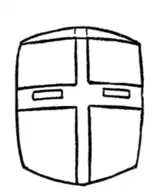 Fig. 565. |
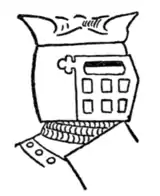 Fig. 566.
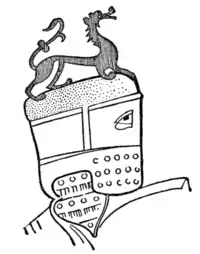 Fig. 570.—"Pot-Helmet," from the Eneit of Heinrich von Veldeke. movable "ventaille," or a visor, instead of the "nasal." This helmet (which was adopted by Richard I., who is also sometimes represented with a conical one) was the earliest form of the large war and tilting "heaume" (or helm), which was of great weight and strength, and often had only small openings or slits for the eyes (Figs. 565 and 566). These eyepieces were either one wide slit or two, one on either side. The former was, however, sometimes divided into two by an ornamental bar or buckle placed across. It was afterwards pointed at the top, and otherwise slightly varied in shape, but its general form appears to have been the same until the end of the fourteenth century (Figs. 567, 568). This type of helmet is usually known as the "pot-shaped." The helmets themselves were sometimes painted, and Fig. 569 represents an instance which is painted in green and white diagonal stripes. The illustration is from a parchment MS. of about 1241 now in the Town Library of Leipzic. Fig. 570 shows another German example of this type, being taken from the Eneit of Heinrich von Veldeke, a MS. now in the Royal Library in Berlin, belonging to the end of the twelfth century. The crest depicted in this case, a red lion, must be one of the earliest instances of a crest. These are the helmets which we find on early seals and effigies, as will be seen from Figs. 571-574.
The cylindrical or "pot-shaped" helmet of the Plantagenets, however, disappears in the latter part of the thirteenth century, when we first find mention of the "bascinet" (from Old French for a basin), Figs. 575-579. This was at first merely a hemispherical steel cap, put over the coif of mail to protect the top of the head, when the knight wished to be relieved from the weight of his large helm (which he then slung at his back or carried on his saddlebow), but still did not consider the mail coif sufficient protection. It soon became pointed at the top, and gradually lower at the back, though not so much as to protect the neck. In the fourteenth century the mail, instead of being carried over the top of the head, was hung to the bottom rim of the helmet, and spread out over the shoulders, overlapping the cuirass. This was called the "camail," or "curtain of mail." It is shown in Figs. 576 and 577 fastened to the bascinet by a lace or thong passing through staples. The large helm, which throughout the fourteenth century was still worn over the bascinet, did not fit down closely to the cuirass (though it may have been fastened to it with a leather strap), its bottom curve not being sufficiently arched for that purpose; nor did it wholly rest on the shoulders, but was probably wadded inside so as to fit closely to the bascinet.  Fig. 579. It is doubtful if any actual helm previous to the fourteenth century exists, and there are very few of that period remaining. In that of the Black Prince at Canterbury (Fig. 271) the lower, or cylindrical, portion is composed of a front and back piece, riveted together at the sides, and this was most likely the usual form of construction; but in the helm of Sir Richard Pembridge (Figs. 580 and 581) the three pieces (cylinder, conical piece, and top piece) of which it is formed are fixed with nails, and are so welded together that no trace of a join is visible. The edges of the metal, turned outwards round the ocularium, are very thick, and the bottom edge is rolled inwards over a thick wire, so as not to cut the surcoat. There are many twin holes in the helmet for the aiglets, by which the crest and lambrequin were attached, and in front, near the bottom, are two + shaped holes for the T bolt, which was fixed by a chain to the cuirass. The helm of Sir Richard Hawberk (Figs. 582 and 583), who died in 1417, is made of five pieces, and is very thick and heavy. It is much more like the later form adapted for jousting, and was probably only for use in the tilt-yard; but, although more firmly fixed to the cuirass than the earlier helm, it did not fit closely down to it, as all later helms did. Singularly few examples of the pot-helmet actually exist. The "Linz" example (Figs. 584 and 585), which is now in the Francisco-Carolinum Museum at Linz, was dredged out of the Traun, and is unfortunately very much corroded by rust. The fastening-place for the crest, however, is well preserved. The example belongs to the first half of the fourteenth century.
The so-called "Pranker-Helm" (Fig. 586), from the chapter of Seckau, now in the collection of armour in the Historical Court Museum at Vienna, and belonging to the middle of the fourteenth century, could only have been used for tournaments. It is made of four strong hammered sheets of iron 1-2 millimetres thick, with other strengthening plates laid on. The helmet by itself weighs 5 kilogrammes 357 grammes. 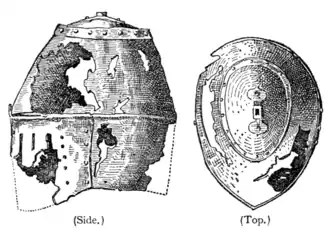 Figs. 584 and 585.—The "Linz" Pot-Helmet. 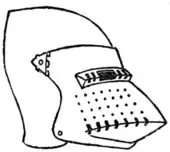 Fig. 587. 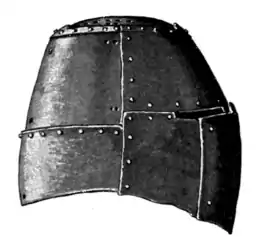 Fig. 586.—Pranker-Helm.
|
